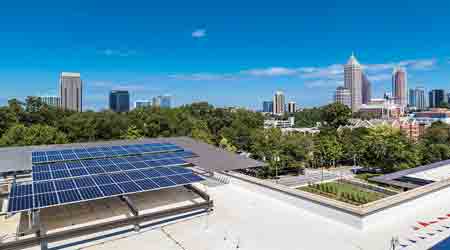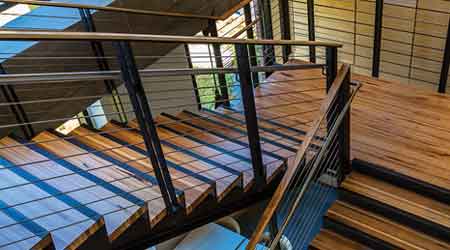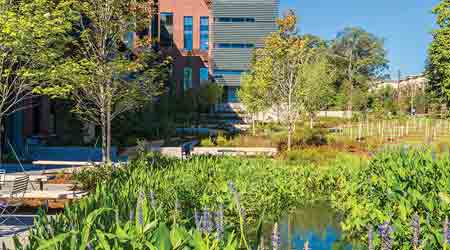7 Strategies for Sustainability in Higher Educational Buildings
From LEED to LEDs, follow these best practices for the highest level of sustainability in higher ed facilities.
OTHER PARTS OF THIS ARTICLEPt. 1: This Page
In the last decade or so, green building has grown exponentially, and facility managers have a variety of sustainable options to meet their needs and align with their core values. If you are thinking about the sustainability of your current or future project, here are seven things to consider before beginning.
1. Define your sustainability philosophy
The first thing you must do is define your sustainability philosophy or core values, or simply outline your sustainability goals. How much of an environmental impact do you want to make? Is there a specialized certification you are trying to obtain? What features are most important to you? The architect and the contractor must have a good understanding of your sustainability philosophy to meet your needs. This helps ensure that they are aligned with your interests and avoids the waste of time or money.

(Georgia Tech saw investing in solar panels as a commitment to energy savings and sustainable practices in the Roger A. and Helen B. Krone Engineered Biosystems Building.)
Recently, the facilities operational team at the Georgia Institute of Technology communicated its goals for the Roger A. and Helen B. Krone Engineered Biosystems Building, a LEED Platinum-certified laboratory. This owner’s philosophy focused on energy reliability and maximizing renewable sources, which required adding solar panels to the building for electric lighting and water heating. Solar panels are costly and, for a building of this nature, can take more than 40 years to pay off the equipment investment. However, the owner saw investing in solar panels as a commitment to energy savings and sustainable practices.
2. Request a green job site
Contractors can implement sustainable techniques at the job site, bringing the green mentality full circle. Green job sites foster an environmentally friendly culture, serving as a constant reminder of the goals to save energy and recycle resources anywhere possible.
For example, green job sites may feature specialized construction trailers, dubbed green trailers. They are equipped with motion-sensor lighting to save energy, and are built with energy-efficient walls, windows, and roofs. On the construction site, temporary LED lighting on timers can be used, as well as virtual plans on tablets or kiosks to reduce paper waste.

(Trees felled on the construction site were used for stairs in the Engineered Biosystems Building.)
Material from the demolition can be recycled where possible, regardless of project requirements. In the Engineered Biosystems Building project, trees cleared from the site were used as finishes for the building. It is also important to consider the power source during construction. If a renewable energy source is being installed, it can be done early, so that it can be used as a power source rather than continuing to use non-renewable energy.
3. Consider certifications
As you define your sustainability philosophy, consider a LEED certification, which evaluates the environmental performance of a facility and encourages sustainable design and building practices. Once certified, the building may be eligible for substantial tax breaks. There is a registration fee to certify the project, but otherwise certification can result in millions of dollars in tax savings over the life of the building, not to mention lower energy costs, operating costs, and improved indoor environment for employees and occupants.
Separate from LEED certification, there is the Living Building Challenge by the International Living Future Institute, a challenge endorsed by the U.S. Green Building Council. There are only 380 registered Living Building Challenge projects in existence around the world. Living Buildings must demonstrate that they have achieved net positive energy, net positive water, and net positive waste. Simply put, they generate more energy than they consume.
If you want to become LEED certified or participate in the Living Building Challenge but are not familiar with the process, hire a team of design professionals, construction professionals, or a sustainability consultant with the right experience.
4. Go net zero
Net Zero buildings produce as much energy as they use in an operating year. To achieve this, building teams first model energy usage, changing building design to minimize energy usage, and then add renewable energies, like wind and solar, or use purchased power agreements to make up for any energy expenditures.
One benefit of a net zero building is the consistency of energy costs. Knowing the building will produce as much power as it needs takes the guesswork out of energy operating costs.
By 2025, California will require net zero energy for all new buildings. Other cities around the world have also set net zero requirements on new construction to take effect as early as 2030. As the world prioritizes sustainable energy usage, the construction industry is honing cost effective ways to meet these goals with new materials and techniques.
5. Compare techniques and materials
Construction techniques can make a substantial difference in your environmental impact. One of the most impressive new techniques employed at Georgia Tech’s Engineered Biosystems Building was the use of chilled beams instead of a standard chilled water loop. Before building the new lab, the owner tested and proved the beams would significantly minimize energy use.
After the first full year of occupancy, Georgia Tech reported that the building was operating at six percent (6 percent) below the established goals outlined in the basis of design. The chilled beams played a significant role in lowering the building’s energy use compared to other laboratories of similar size and occupancy.
Additionally, new materials, like low VOC adhesives and paint systems, are more efficient and cost-effective. In the past, there was often only one option for sustainable materials. Now there are a range of options to property owners so they get the look and feel they want for their facility while reducing waste. At your project, you should examine a range of sustainable materials options.
6. Calculate operating cost savings
The true benefit of green building is cost savings. Buildings that reduce water and energy use are not only environmentally friendly, they are more efficient and will reduce operating expenses. Work with the project team to model the building’s energy use and calculate how cost-saving features can impact your bottom line. Decisions should be based on life cycle cost analysis, which includes the first cost and operating cost to evaluate investment and payback, not just lowest first cost.
Certain features save more in different regions. In the Southeast, reducing water usage is one of the best ways to cut operating costs without increasing construction costs. For example, consider features that recycle water on-site, taking advantage of the Southeast’s high rainfall and reducing need for a water utility. Georgia Tech’s laboratory captures ground water, storm water, and condensate from HVAC to recycle it for irrigation and toilet flushing. This was an easy, cost-effective way to save Georgia Tech money on long-term operating expenses.
Implementing cost-saving features is easier than ever. Sustainability has become a priority across the country, which has increased demand and development of sustainable products and consequently lowered costs. As the demand for green building increases and the best minds continue to explore new techniques, sustainable construction methods will become even more available and cost-effective.
7. Involve your community
A sustainable education building changes the way students, faculty, and the surrounding community think about sustainability. Green buildings show that your organization is thinking consciously about its impact.
Engaging the community and involving them in the building process amplifies the impact on campus. These days, sustainability is an expectation on higher education campuses. Tapping into campus culture is vital to ensure the features students and educators will enjoy are included in the finished product. At Georgia Tech, building tours were frequently conducted during construction to demonstrate how community demands were being addressed and to continue to build excitement about the building’s completion.

(The Engineered Biosystems Building captures ground water, stormwater, and HVAC condensate and recycles it for irrigation and toilet flushing.)
Facility operating staff should also be involved in the design process. This will make the transition from construction to operation much smoother. Operators will learn how to use and maximize new sustainable features. It also makes sure the operators’ needs are met. At Georgia Tech, the Engineered Biosystems Building’s facility operators were consulted on building finishes and design to improve operating efficiencies, reliability and durability.
Finally, think about how the building can play a larger role within the campus. For example, if there is water that runs through the building, can the building improve the water as it feeds into the rest of the campus? Such considerations can make the new building a vital asset that the community is proud to have on campus.
Ben Watkins is vice president of operations in the Atlanta office of McCarthy Building Companies, contractor for the Engineered Biosystems Building.
Email comments to edward.sullivan@tradepress.com.
Related Topics:















